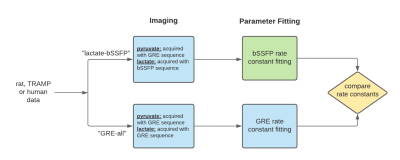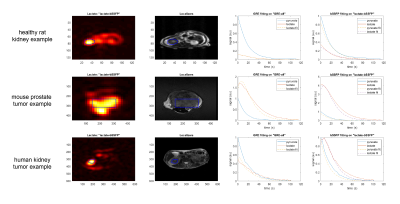Sule Sahin1,2, Shuyu Tang3, Manushka Vaidya2, and Peder E.Z. Larson2
1Graduate Program in Bioengineering, University of California, Berkeley and University of California, San Francisco, Berkeley, CA, United States, 2Radiology, University of California, San Francisco, San Francisco, CA, United States, 3HeartVista, Inc., Los Altos, CA, United States
1Graduate Program in Bioengineering, University of California, Berkeley and University of California, San Francisco, Berkeley, CA, United States, 2Radiology, University of California, San Francisco, San Francisco, CA, United States, 3HeartVista, Inc., Los Altos, CA, United States
A model was developed for hyperpolarized [1-13C]pyruvate
studies where lactate was acquired with a bSSFP sequence. This model was shown
to fit in vivo data of these bSSFP acquisitions better than using a GRE fitting
method.

Figure 1: Flow chart describing the “lactate-bSSFP” and “GRE-all” experiments.
The novelty in this work is the bSSFP rate constant fitting (green
square).

Figure 4: For all three types of in vivo data, an example of a lactate image
acquired in the “lactate-bSSFP” experiment and the corresponding localizers. The
kidney ROI for healthy rats and the tumor ROI for mouse prostate and human
studies are outlined in blue. The signal from the ROI was averaged to get the
time courses. The plots show “GRE-all” time courses fit using the GRE fitting
and the “lactate-bSSFP” experiment time courses fit with the bSSFP fitting.
